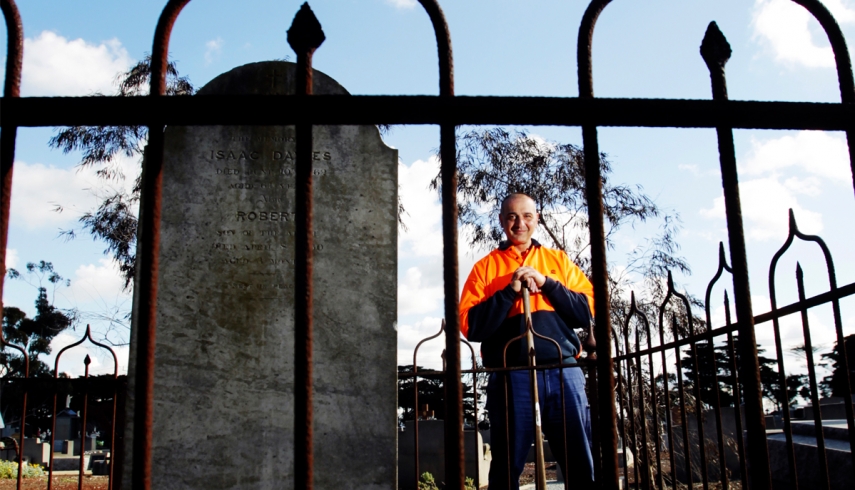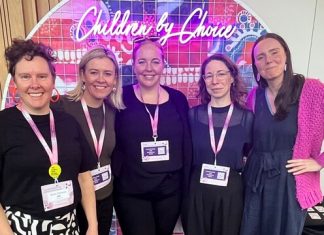Baby-boomers want more ‘personalised’ funerals, at home or in a park. Embalmers’ training has changed, too. But grave-digging is still about getting ‘down and dirty’. Melissa Cunningham has been delving in an industry that assuredly will never die.
WHEN Ian Warren was young, he used to tell people at parties that he worked for Telecom. It was the only way the 52-year-old embalmer could escape being cornered and drilled with bizarre questions about his profession for the rest of the night.
‘‘I used to come unstuck sometimes because people would say, ‘Oohh, actually, my phone’s not working’ and ask me for help,’’ he says with a chuckle.
For more than 30 years, Warren, who works at Nelson Bros Funeral Services in Footscray, has doubled as an embalmer and funeral director.
In those years there have been profound changes in the way Australians deal with death and bereavement. ‘‘The funeral industry is changing,’’ he says. ‘‘Baby boomers are calling for a more individual-style funeral. More funerals are taking place in personalised venues, at home or outdoors in parks — even at the person’s favourite watering hole.
‘‘It’s becoming a celebratory service of the person’s life with formal and informal sections.’’
While Warren sees his two roles as being one, he thrives on embalming. ‘‘To me, embalming is the more meaningful part of the job. You are really using your creativity. It’s a balance between a science and an art.’’
A lot of the time family aren’t with a person when they die, so Warren’s role entails preparing the deceased for their family to farewell.
‘‘We do a detailed analysis of the person, trying to get as much information as possible about cause of death, their age and the time we have left before the funeral service. Then we disinfect the body, set the person’s facial features and begin the embalming process.’’
Embalming is done for three reasons: to temporarily preserve the body, to disinfect it and give the deceased a more natural appearance.
‘‘Some families are very definite about what they want to do,’’ he says. ‘‘They may want to apply the make-up or dress the deceased because it’s the last thing they can do for their loved one.
‘‘Some will want to view their loved one, while others may not. If they choose not to, we might encourage them to reconsider because viewing is known to help with the grieving and healing process by giving the individual a sense of closure.’’
The last element is dressing the person. ‘‘We’ve had burial clothing requests that have been anything from fancy dress to something they wore 20 years ago.
‘‘Wedding dresses are also popular and some women to their credit can still fit into their dress. Other times it can prove a bit more difficult to get the dress to fit. Some people have even asked to have a second doctor come in and certify they are dead because they have a fear of their loved one being buried alive.’’
The strangest request he’s ever had remains a man whose dying wish was to be buried in a circus clown suit.
In the time Warren has been in the industry the training to become an embalmer has changed.
‘‘There are more training options available today,’’ he says. ‘‘There have also been breakthroughs in embalming fluids and there’s more knowledge about how to deal with difficult cases. But you really have to take each case as it comes and on its own merit.’’
His desire to help others drew him to the role.
‘‘I wanted to help people through the hardest times of their life. If you can help them, make that time a little easier for them, then it’s worthwhile. [Death] is a as much a part of life as anything else.
‘‘To do this job, I guess in the back of your mind you do have that false perception that it’s not going to happen to you.’’
Funeral director at Tobin Brothers Funerals Cathy Tobin says the funeral industry is embracing change as the emphasis slowly shifts from death to a life lived.
‘‘We’re seeing funerals become more informal, more celebratory and a move away from traditional funerals in churches.”
Rather than being a sombre and stoic event, she says the ‘‘dying and their loved ones are celebrating a life lived in a more personalised way’’.
The funeral industry is embedded in Tobin’s veins. Her first memory of the industry goes back almost 50 years. She was four and clutching the hand of her grandfather Leo, one of the founding brothers of the now iconic Tobin Brothers name.
‘‘For some reason, I had gone to work with him that day and he opened the door and there was this man just lying there peacefully in his coffin. After all these years, I still remember it vividly.’’
Death and grief are part of the working day for the 53-year-old Strathmore resident, who joined the family business more than a decade ago.
‘‘You don’t always see that raw grief but I suppose as humans we do a very good job at covering it up,’’ she says. ‘‘You can feel it. Sometimes you can nearly touch it … it’s just there filling up the room. When I am with a family initially I just sit there, watch their body language then ask what they would like me to do.
‘‘A lot of times they don’t know what to do, but that’s why we’re there, to advise and help them make an informed decision.’’
She takes on the responsibility of the service and ensures everything runs as the family requested.
Songs like Time To Say Goodbye by Andrea Bocelli and Ave Maria are still favourites, but Tobin says there has been a move towards contemporary music and revamped versions of traditional songs like Anthony Callea’s rendition of The Prayer.
While she has heard of Ding Dong the Witch is Dead and Another One Bites the Dust by Queen being played, it hasn’t been at any of the of the funerals she has planned yet.
Empathy and compassion are an integral part of the job.
‘‘I think in a way if you weren’t emotional at all then you need to step back a bit,’’ she says. ‘‘This isn’t just a job. If you don’t have that emotion or feel for that family in some way you need to reconsider what you are doing. But after that funeral is over you need to let it go because if we didn’t we would be carrying so much with us and we need to be able to offer the next family we meet the same service.’’
After the funeral it’s on to finding that perfect patch of land.
A piece of the earth where the person will rest peacefully for eternity.
Carmello Falzone has been a grave digger and maintenance worker at the Keilor cemetery for 10 years.
Falzone says he sees his role as doing the ‘‘last special job’’ you can for someone.
‘‘People love it when I tell them what I do,’’ he chuckles. ‘‘They say to me they’ve never met anyone who’s a grave digger before.
‘‘First question they ask is if I have ever seen a ghost. I’ll always tell a few stories to amuse them. But I haven’t seen a ghost yet.’’
He says his role of maintaining the gardens, digging graves and positioning coffins in the ground hasn’t changed much in the past decade, but the tombstones around him continue to evolve.
‘‘They’re becoming a lot more extravagant, more detailed and elaborate. People are becoming more particular about what they would like to have above them when they die and they are planning where they want their body buried before they die.’’
While he’s used to being faced with death every day, there are some deaths that still hurt.
‘‘I find it very hard to do the burial of a baby because that’s just not right,’’ he says. ‘‘Or when a person has died and there’s nobody at their funeral except the funeral directors and staff from the cemetery; that can be really heartbreaking.’’
But most days the 45-year-old loves his job and the appreciation it makes him have for his own life.
‘‘I’ve changed my views after working here,’’ he says. ‘‘People I talk to say how they are paying off their third house, or they’ve just brought another car. At the end of the day, you aren’t going to bring it with you.
‘‘I’ve realised you have to take in all life’s special moments and appreciate the relationships you have with people more than what you own. It’s just life, isn’t? We’re all born and raised and eventually we all pass away and when we die there’s a new baby born into the world that replaces us.’’








